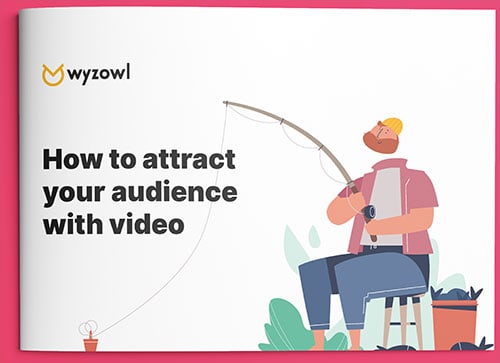Around the world, video usage has soared over the past few years.
If you’re a marketer, you and your team are likely thinking about how to use video to deliver ROI for your business, and you’re not alone. According to our Video Marketing Statistics 2024, 91% of businesses use video as a marketing tool in 2024, and 88% of businesses agree that video is an important part of their marketing strategy.
But creating great content isn’t the only effective video marketing strategy; many marketers are looking to video SEO to support their content efforts and drive traffic, boost conversions, and outperform the competition.
There’s plenty of evidence that proves video SEO is a necessary consideration for any high-performing SEO strategy.
One of the reasons video improves SEO is because it can increase overall engagement on your website, which is critical for success with search engines.
For example, when people watch a video on your website, they often spend more time on your site than they would scrolling through text.
Videos also help customers quickly and easily understand your product, and when someone understands your product and its benefits, they’re more likely to visit other pages to find more information.
Even with this knowledge, many marketers still under-utilise video SEO when crafting their digital strategy. As you move beyond copywriting and keywords and begin considering how video SEO can improve your search rankings, use this ultimate guide to fuel your journey. It’s packed with practical and actionable tips you can implement today to start boosting your search engine results.
What is video SEO?
Video SEO is the process of optimising your video content to improve its visibility and ranking on search engine results pages, or SERPs.
But none of those statistics matter unless they’re able to find your video in the first place.
Video SEO makes it possible for consumers to find your video content online. More important than the definition of video SEO is how you can use it to your benefit; for that information, keep reading as we tell you how you can leverage emerging video SEO best practices to take advantage of the trend your competition is likely ignoring!
The benefits of video SEO
Before we dive into specific tactics and best practices you can implement to optimise your video SEO, let’s take a look at its benefits. Here are the top advantages of a well-formulated, well-executed video SEO strategy.
Video increases your website’s core SEO KPIs
You’ve got great video content on your website, and your target market is looking for that content to answer their questions. If they can find your content, and if your content satisfactorily answers their questions, they’re more likely to visit your website (increased traffic), stay on your website (decreased bounce rate), and spend longer periods of time on your website (increased dwell time).
Since dwell time is also a primary ranking factor for search engines, those improved performance metrics fuel your search rankings.
Think about it this way:
Google wants to optimise the experience for its users and serve up the most engaging, relevant content given the user’s search term.
If Google sees that visitors are staying on your website for long periods of time after completing a search, it’s going to assume you’ve successfully answered the user’s question. Then Google is more likely to serve up that same successful experience to future searchers.
On the other hand, if a user comes to your site and quickly leaves, Google takes that as a sign that your content hasn’t done the job, and will be less likely to recommend your page to searchers in the future.
Video results in SERPs increase click-through rates
SERPs are the pages users see after completing a search in a search engine. As you can see in the example below, SERP listings with an associated video and thumbnail are much more attractive than text-based listings, and there’s data to prove that they’re also more effective.

That means having video on your website makes it both more likely that users will see it in their search engine results, and also more likely that they’ll click through and watch your content.
Video can lower bounce rates
If given the option, 73% of people would rather watch a video to learn about a product or service than read about it in text, so it makes sense that video content would engage new website visitors better than copy alone. Including a video on a landing page is a perfect way to address high bounce rates and improve your SEO rankings.
When Google sees that users found your site on a SERP and then stayed on it for a while, it confirms that your page answered whatever question the user had. Google may then reward that positive user experience with better rankings in search queries.
Video SEO reinforces keyword strategies
By now you’ve likely got an existing keyword strategy in place, and video can easily supplement that approach. Whether you’re hosting your video on your website or on an alternate platform, you can include your video transcript below the video or in the description. That then gives Google an extra body of text to index, effectively boosting the likelihood that your content will show up in a user’s SERP and in turn boost your organic traffic.
Great videos earn backlinks
Backlinks are hugely important to a high-performing video SEO strategy. Choosing to promote and endorse someone else’s content is the highest honour one website can give to another, and Google recognises that as an important factor when ranking content. Not only does that then improve your SEO results, but it also increases the number of places where your content is linked, thus increasing the likelihood that it will drive traffic to your site.
Videos on your website vs. a video platform
When it comes to choosing how and where to display your video, you have two options: you can embed your video on your website, or you can upload it to a video platform like YouTube or Vimeo. Ideally you should do both.
Why?
Embedding a video on your website
When you embed a video on your website (by uploading it to a business video platform like Wistia and embedding it on your site), your visitors can see your content in context and watch it without ads. This both enhances your visitors’ experience and also helps amplify your video SEO on Google.
When users search for videos on Google, the search engine populates its results with videos pulled from websites.
As is shown in the example below, when you search Google for videos about wedding invitations, videos from Basic Invite, a custom wedding stationery website, fill the results. The fact that this company holds the top four spots under such a common term shows they clearly have their website-hosted videos optimised for SEO.

Hosting a video on a video platform
When you host a video on YouTube or Vimeo, you’re using the traffic those sites already get to your advantage. For example, when YouTube’s 2.3 billion monthly users or Vimeo’s 230 million search for videos on those platforms, they’ll be able to find your content in search results as well as suggested videos, putting your content in front of an audience that otherwise might never have known about your brand.
4 ways to maximise video SEO on your website
When you put videos on your website, it’s very likely your site performance and SEO will improve as a result. When visitors are informed about your product and understand its value – a process that’s made much easier with video – they’re more likely to spend more time on your site, visit more pages, and generally engage with your content more.
It’s easy to see that using video on your website directly impacts your SEO, but how can you use video to maximise your website SEO?
Here are 4 pieces of advice to follow to help you maximise your website SEO with video.
1. Put your video at the top of the page
When you place your video at the top of your web page, this shows Google that your video is the primary piece of content on your page, making the search engine more likely to promote it in search results. Take advantage of this insight by putting your videos at the very top of your landing page, or immediately following a brief introduction. But be aware: according to SEO expert Phil Nottingham, you shouldn’t spend time and resources promoting two videos that live on the same page as Google will only index one.
2. Always use video schema
Video schema markup is the HTML code that exists to explain what your video is about to a search engine. Content like the video’s title, description, upload date, and even your thumbnail URL all play an important factor in your SEO results. This microdata helps Google make sense of your web page and the content on it, including your video, and also empowers the search engine to populate rich snippets in search engine results.
Keep in mind that if you don’t include this markup, your page will always be less visible than it would be if you’d included schema. The more quality markup exists, the easier it is for search engines to find your content, understand it, and serve it up appropriately. Some schema is required, while some simply improves your SEO results, but as a baseline, your video schema should include:
Description: Provide some details about the content in your video, but don’t go overboard. Keep this description to about 160 characters, and use the transcript to provide more information.
Thumbnail URL: Don’t leave your thumbnail image to chance. Include the URL of the exact frame you want to appear in a SERP to catch the eye of your target audience.
Duration: Your video’s length is important to most viewers. Google pulls this data to populate the video duration label on the thumbnail, helping searchers find the right video for their needs.
Upload date: This is a property required for Google to appear in search results.
Transcript: Since you didn’t get much space to explain your video in detail in the description, include a transcript to provide more information – and more keywords. This is extremely important as it helps Google fully understand what your video is about and “see” the content of your video.
While the above includes the required and most critical properties as they relate to SEO, your video markup can include many other properties, like an expiration date. For a thorough review of the markup Google scans and how it’s used, visit their guide to video.
Tactically, as you set out to improve your video markup to enhance your SEO, you have a few options. If you have a development team skilled in HTML, they should be able to handle this request. However, there’s also a free tool you can use. Sistrix is a schema generator; if the video you’re writing markup for is already hosted on YouTube or Vimeo, simply copy and paste the link to the video into Sistrix and voila – the tool spits out markup for you.

3. Publish a transcript on the same page
The same way blog content helps Google understand your web page, a video transcript gives search engines insight into what your video is all about, potentially boosting your site’s ranking. Consider including a transcript directly under your video content to amplify your keyword performance, like inbound marketing firm Denamico does in the example below.

As an added bonus, this best practice helps your viewers who might be somewhere noisy where they can’t listen to your video but still want access to its content.
4. Give your video a page of its own
If you choose to self-host your video, your video should have a page of its own. The page could be a landing page specifically created to host that video exclusively, or a topical page with other content (like a blog post) that’s enhanced by a video – like the example below.

When you create that page, ensure the page title, page description, and header tags are all in place so Google can find, index, and rank your web page appropriately.
4 ways to maximise video SEO on a video hosting platform
Embedding a video on your website is a great option if you want people to experience your video within your website, however, it’s certainly not the only option. There are several credible and professional video hosting platforms you can leverage to improve your video SEO, like YouTube and Vimeo. Let’s take a deeper look at those popular options.
- YouTube: YouTube is the second-largest search engine in the world, just after Google. That means when you host your video on YouTube, you’re taking advantage of the traction and audience YouTube has already established (like its 5 billion daily video views). As an added bonus, when you host on YouTube, your video is also more likely to show up in Google search results; 82% of all video results in Google are pulled from YouTube.
- Vimeo: While Vimeo isn’t as popular as YouTube, it does have a more professional reputation, which might be important if your brand is super buttoned-up. On YouTube, your video might be flanked with thumbnails promoting cat videos and epic fail compilations. On Vimeo, however, you’ll be at home with content that usually has much higher production quality and a professional subject matter. Vimeo is also ad-free, which means your video won’t be introduced or interrupted by a commercial you’ve never seen or endorsed.
Regardless of which platform you pick, there are some general best practices you should follow to improve your video SEO on these platforms. Here are 4 tips for improving your SEO when you host your video on YouTube, Vimeo, and other video hosting sites.
1. Optimise your title, meta descriptions and tags
As you’re uploading a video onto a hosting site, you’ll be asked to enter information about the video like its title, description, and other data. Similar to the way HTML markup on your website gives search engines context clues about your website’s and video’s content, this information helps video platforms understand your video and display it during relevant user searches. Include the following elements for the best results:
Description: Use keywords in your description, but also explain the topic so viewers clearly understand the value it brings.
Tags: Tags are words or phrases that categorise your video, like “digital marketing” or “baseball tips.” Video platforms reference these tags to display relevant results on user SERPs. Include your video’s topics as tags to improve your video SEO, but don’t put tags where they don’t belong. Including tags in other places, like your description, could lead to your video getting flagged and removed.
Transcript: Many video hosting platforms, especially paid platforms, may let you upload a transcript separately. If that isn’t an option for you, put a video transcript in the description section to pack as many keywords and search phrases into your metadata as possible.
2. Write your video script with SEO in mind
Since your transcript can be used to boost your video SEO, start thinking about search terms as you’re writing your script. The same way you naturally work search phrases into blog and website copy, incorporate your video search terms into the script.
Later, when you paste the transcript into the video’s description, it will already be optimised for searchability. Use a tool such as Keywords Everywhere or Keywordtool.io to find out what search volume and competition there is for the keywords you are optimising for.
3. Get the viewer hooked in 10 seconds – and keep them around
The average person has an attention span of about 8 seconds – shorter than that of a goldfish. This doesn’t bode well for marketers whose primary goal is to engage today’s easily distracted consumer. However, we can use these insights to optimise video content. Studies continually show that marketers have about ten seconds to engage an audience. After those ten seconds are up, viewership starts to drop off at rapid rates. This means as you’re scripting your video, you need to focus on those first few moments so your viewers continue watching your content.
Engaging viewers initially is important for earning views, but keeping them around is critical to video SEO. Just like Google, video search engines want to serve up the most relevant content to users. That means videos that have longer watch times are ranked above videos that viewers abandon early. But that doesn’t necessarily mean a longer video will perform better. A short video that’s watched from beginning to end will outperform a 10-minute video that’s only watched for a minute or two. While those first 10 seconds are critical to the viewer experience, your entire video should be packed with engaging, relevant, value-adding content that earns long-term views, not just empty clicks.
4. Choose an intriguing thumbnail
Many video hosting sites will automatically select a thumbnail based on an arbitrary measurement, like the image on screen halfway through your video. But your video’s thumbnail is one of the first things users will see, and it will surely impact their decision to watch your video. What if that auto-selected image is of your narrator caught mid-sentence with his or her mouth open at an awkward angle? While you might earn a chuckle or two, you probably won’t earn many views.
Instead of letting a third party decide your fate, upload your own thumbnail image. Consider something bright and colourful, something informative (like a word or information graphic), and something that reinforces that your video will answer your viewers’ question.

Why does your thumbnail ultimately matter for SEO?
Having a compelling thumbnail can improve your click-through rates, and CTRs are a strong factor in search algorithms; the higher your CTR, the more likely you are to rank higher in search results.

If you need a little inspiration, take a look at this article: The 7 Best Fonts for YouTube Thumbnails in 2023.
6 tips for promoting your video
Now that you’ve got your video embedded and optimised for search on your website and video hosting platforms, it doesn’t mean your job is done. You can further boost your video SEO by strategically promoting your video. Here are a few effective ways to do just that.
1. Ask people to share your content
Since backlinks are so crucial in an SEO strategy, one of the best ways to promote your video is to ask people to share your content. This could take place on their social media accounts, in their blog, or through any number of digital outlets. Consider reaching out to customers, clients, and fans to ask them to share your video content.
2. Optimise your content for social sharing with Open Graph
Have you ever gone to share content on Facebook and X (formerly Twitter) only to find that the post’s data – image, title, and description – didn’t autofill, leaving you with an empty (and ugly) post? That’s because the content creator didn’t use Open Graph protocol in their code.
Open Graph is data that promotes seamless integration between web content and social platforms. This code tells Facebook or X what image, headline, and description to display when you paste a web link into a social post. Without Open Graph, social networks have to guess what data and images to use, which means your post could look like the example below – certainly not ideal or share-worthy.

With Open Graph, however, your content instantly becomes more aesthetically pleasing and shareable when posted on a social network. Work with your development team to ensure your web pages that include important videos are optimised with Open Graph so the right image, title, and description auto populate when users go to share your content.

3. Feature experts in your videos
There’s nothing wrong with leveraging someone else’s popularity to promote your brand. When you feature a noteworthy person in your video, you’re more likely to get attention, and they might also share your content, meaning your video could reach an influencer’s audience. Consider whether there are thought leaders in your network you could feature in your next video to boost your organic reach. Be sure to include their name in your video’s title and description, and tag them in your social posts for maximum impact.
4. Run a paid video campaign
While sharing your videos with your social followers will earn some traction, sometimes paying to promote your content is worth the cost. Video ad campaigns can be an affordable way to spread the content you’ve already invested in. And since Facebook limits business accounts’ organic reach, you might be forced to pay for promotion if you really want to earn video views on the social network.
5. Share your videos via email
Video and email are a dynamic duo; not only is video a great way to make email much more captivating, but adding a video to your email can increase click-through rates by up to 300%.
Don’t just share your video on social media and on your website; consider running a video email campaign to make the most of your video content.
6. Just create great videos
Video SEO is highly dependent on creating content that your viewers want to watch and share. The best thing you can do to earn better rankings is to create videos that organically earn shares and backlinks – inbound hyperlinks from other websites who include links to your content on their site. When you’re brainstorming video topics, put yourself in your customers’ shoes and produce content that they want or need to consume.
Wrapping up
While video SEO is just emerging as a marketing strategy for many businesses, now is the time to get on board and get ahead of the competition. As you plan to outpace them, consider these key takeaways:
Boost your website performance with video SEO: Video SEO is part of an integrated marketing plan, and when it works for you, it will have a ripple effect. Expect to experience improved website and all-around SEO performance once you start focusing on video.
Host where you’ll get the most benefit: Where you host your videos is not a consequence-free decision. Consider all your options and your ultimate marketing goals before picking YouTube simply because it’s the most popular.
Create your video with SEO in mind: Be sure your video earns attention early and keeps it for the long run if you want to see the true impact of video SEO.
Be sure your videos are technically sound: Get the right metadata, tags, descriptions and titles in place so search engines can find, understand and promote your content. That is – after all – the ultimate goal.
Need a hand ranking higher on YouTube? Our YouTube SEO guide should help you do just that.






